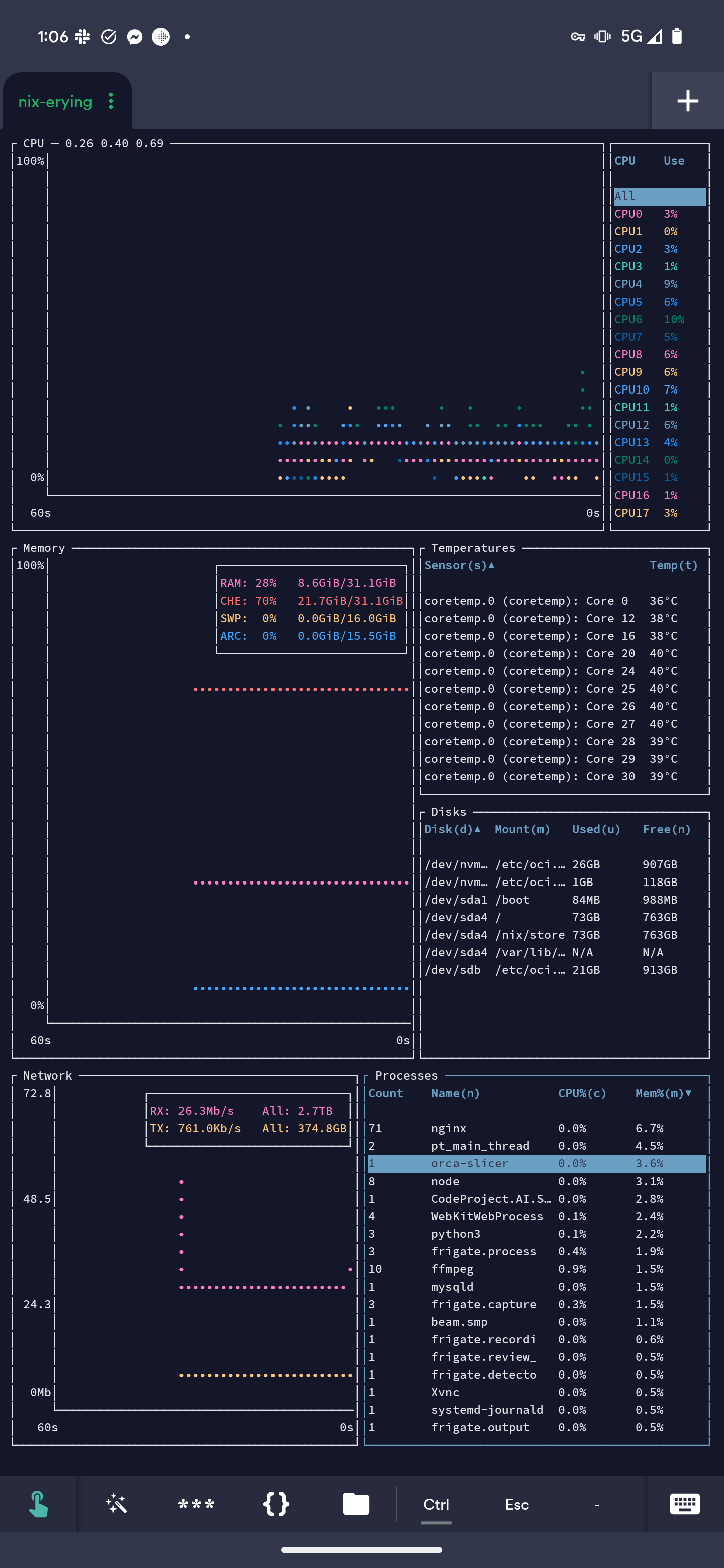Meanwhile the electron app you’re trying to run

The other day my laptop was sluggish as hell, checked top and turns out Discord and Orca Slicer were maxing out my cores
Is Orca that resource intensive? I’m running it in a container with KasmVNC and have never really checked out the resource usage. Admittedly it’s on one of my local servers in another room. I guess it’s how large your projects are too.
Edit: maybe it’s just my small projects

Well, when I leave it open for a while it tends to have issues
What’s the benefit of running Discord’s app instead of just using it as a PWA? A PWA would reuse your existing browser and its session.
Global keyboard shortcuts are pretty nice. E.g. muting yourself without alt tabbing to your browser.
Oh that’s a good point. I totally forgot that Discord has voice features. don’t use Discord often, and when I do, it’s just for text chat. Unfortunately some open source apps I use use Discord for communicating with the developers.
you are right :d
And your browser with 300 open tabs doesn’t even fit into the room
Firefox unloads old tabs when restarting the browser, so most of those are more like temporary bookmarks.
Don’t think I’ve ever seen someone open 300 tabs in one session or on Chromium…
I’ve seen builds of the Linux kernel that comfortably fits in my on-die CPU caches.
So it would just be a picture of an empty sofa.
There are mid range CPUs with 128MB of L3 cache now. A Linux distro like Tiny Core could fit entirely in cache.
Tiny Core Linux is a minimal Linux kernel based operating system focusing on providing a base system using BusyBox and FLTK. It was developed by Robert Shingledecker, who was previously the lead developer of Damn Small Linux.
Ah, that explains a lot! Didn’t know about TCL.
Won’t run on my 386? Well what good is it then.
That sounds neat. Link?
Hm? Do you mean a link to builds that are this small? My midrange Intel i5-12600K (I’m a working man, doc…) L3 cache is 20,971,520 bytes. My Linux Mint (basically Ubuntu kernel)
vmlinuzright now is only 14,952,840 bytes. Sure, that’s a compressed kernel image not uncompressed, but consider this is a generic kernel built to run most desktops applications very comfortably and with wide hardware support. It’s not too hard to imagine fitting an uncompressed kernel into the same amount of space. Does that help to show they’re roughly on the same order of magnitude?Ten years old kernels could be 2 MB.
Gotcha - I thought you meant you had seen some sort of demo/article/whatever with a proof of concept, but I misunderstood.
My ARM board from 2010 has 256MB of memory. It runs an old 3.1 kernel (not attached to internet) , new kernels won’t fit/load. But on that I have OpenMediaVault running SAMBA shares and mindlna to serve music. It isn’t even using 50% of the 256MB
Gives a lot of Space for running Virtual machines.
Also browsers can chew that up fast if you have a lot of tabs, Firefox has managed to do it a few times. At least until I started limiting its RAM to 8GB (best decision ever)
Limit Firefox to 8GB of RAM .desktop file
[Desktop Entry] Version=1.0 Name=Firefox RAM limit 8GB GenericName=Firefox Ram limit 8GB Comment=Limit RAM for Firefox to 8GB; Exec=systemd-run --user --scope -p MemoryLimit=8G firefox Icon=firefox Type=Application Terminal=false Categories=Utility;Development; StartupWMClass=Firefox(To use it with other apps like Chrome or Electron apps just replace the command at the end and startup class with the ones from the program you’d like to run).
Can’t relate, just upgraded my laptop from 32GB to 64GB since VScode would keep closing due to OOM. What? Oh, no, it’s not vscode’s fault…I keep like 5 Firefox windows with 30+ tabs open, like a fucking maniac… Close them? What do you mean “close” them?
Only 30 tabs, you need to bump those numbers up!
I had around 1500 open tabs in Firefox. It was fine. I figured enough was enough and closed them all. Now I close all tabs at the end of the day before shutting down.
I was about to reply to the same thing to another comment about 300 tabs, LOL
When I started hitting OOMs I just downloaded free ram.
(Modifying my zram-generator config to use 1.5x my ram size instead of the measly 4GB – uncompressed – default. Seriously it’s worth looking into, though default depends on your distro)
You only need 1 tab to OOM if that tab is Jira. I’ve literally had tabs take up more than 10GB.
Get sideberry, it allows you to “sleep” unused tabs
same with intellij
I mean, I doubt Kate or Geany or Vim would’ve closed due to OOM, but sure…
Once you fire up a webpage it’ll just dump garbage all over the couch.
Wondering how my 64gb will outlast every other part upgrade my gaming Linux box will get over the years
I used to run VM’s in parallel for my job, which eat RAM like candy. Other than that though, I’ve never had a use case for more than 32GB RAM.
700 tabs + VM?
At work I regularly kiss 32gb with everything open and a VM. When I got my latest machine I made sure to get 64 so I think I’ll be good for a while. 32 gigs lasted me from 2017 to 2024. And if I need more this machine takes 2 SODIMMS so I can install at least 96 gigs.
Fixing a SSAO bug where indices overflowed the 32bit int on the gpu I had to use 64GB. Since then I have never needed more than 32GB and at home 24 is way more than I need.
Well, I just remembered, actually I did need more once for a fftv bug (same story, 32bit overflow) but I borrowed a 192GB pc for that.
Your use case is obviously different, but I’ve gone years between system upgrades. I mostly do OSS coding, or work stuff; not gaming. The only case I can imagine needing to upgrade my little Ryzen with 16 cores - a laptop CPU - is if it becomes absolutely imperative that I run AI models on my desktop. Or if Rust really does become pervasive; compiling Rust programs is almost as bad as compiling Haskell, and will take over my computer for minutes at a time.
When I got this like micro, the first thing I did was upgrade it to 64GB of RAM, because that’s the one thing I think you can never have too much of; especially with the modern web and all the shit that brings with it; Electron apps, and so on, absolutely chew up memory. The one good thing about the Rust trend is better memory use, so the crappy compile times are somewhat forgiveable.
Somewhere around 2017 I bought an old dell precision from 2011 for $25, put a radeon rx 570 in it a few years later and used it as my main computer until last year when I finally got around to building a replacement
Plenty of room left over for my Chrome tabs
Four of them.
Java would like to hog the couch
Minimum requirements to run
hello worldin Java
Microsoft Flight Simulator: A whole airplane on the couch
well it’s in the name
“Microsoft”
yeah sure close enough! :)
Try realizing ten thousand mesh instances in Blender and watch that sucker eat the rest of your RAM like it’s got a pebble in its shoe.
I did that on my work PC with 128 GB memory (originally built for esports shit) and it still wasn’t enough.
What fucking e sports game need 100gb of ram…
It was also supposed to be an all-in-one recording/streaming computer for university events, and they had to use the budget for something. It ended up being used as a proxmox host for a while, then it was handed off to me. Now the most resource-intensive thing it runs is a Windows 11 VM that I
torture mercilesslyuse for experiments. It rarely gets to 10% memory utilization.Aaaaah, that make slightly more sense? How old is the computer roughtly?
It has an i9 10980, so about 4-5 years old. It was built before I was hired.
Y’all need to point me towards one of those tiny Linux systems. I have an old no-longer-bricked Toshiba Satellite that somebody gave me and I got it to boot again, so I slapped Mint on it to see how I liked it since I’ve never messed with that distro before. The only problem is this sucker is a dog, it’s only got 2 gigs of RAM and a pokey 5400 RPM platter drive in it. The thing sits there and thrashes swap constantly even when it’s doing nothing, and when Mint is creating one of its automated system image rollback things it’s completely unusable. I’m surprised the laptop platters don’t escape their casing and bore into the Earth like a drill bit.
I found that it will… eventually… load and run the latest FreeCAD build and once it’s going it’s actually not bad (awful screen resolution and single touch only trackpad notwithstanding). But getting there when taken altogether takes about 20 minutes…
If you can afford it, a SSD will significant improve your life. Also, any more memory will help.
As others said, you can disable swap.
Are you running the xfce version of Mint? It’s significantly less resources.
you can disable swap.
Be careful with disabling swap if you don’t have a very large amount of RAM, as many apps rely on memory overcommitment and a large virtual address space, which can behave erratically without swap.
You’d be better off keeping swap enabled and instead setting
vm.swappiness = 0in sysctl.conf.Swappiness is a value between 0 and 100, where 0 means to never swap unless absolutely necessary (only if you completely run out of RAM), and 100 means all programs and data will be swapped nearly instantly. Think of it like a target for the percentage of RAM to keep available. The default is usually 40 which is fine for a low-RAM system, but swaps way too often for a system with more RAM.
I use bunsenlabs helium on my old vaio a series laptop. I use a 32 bit non pae build bc it’s a pentium M that might not support pae. It uses a window manager over a desktop environment.
I’d recommend using a 32 bit distro as they tend to take up a little less ram.
Also I’m on a 4200 rpm PATA HDD. It has 2 gb of ddr ram. It’s slightly too old to get ddr2 which is unfortunate.
More than enough for MX Linux with Xfce. But it’s not going to make your applications a whole lot faster.
Antix will run on old grey boxes with mb of ram, it oughta work for you too.
can you not disable swap? force it to stick to physical RAM.
You absolutely need swap on a low RAM system. It’s the only way the system will actually be usable. You’ll hit OOMs (out of memory errors) that take down the whole GUI if you turn off swap on a system with only 2GB RAM. You can only really turn off swap if you have a very large amount of RAM, and even then, it’s safer to keep it enabled and set swappiness to 0 instead.
most of these old systems dont have soldered RAM a few extra gig of DDR2 RAM would be dirt cheap on ebay too
Arch, with XFCE and the strict bare minimum. Ex : midori instead of firefox, etc. Don’t dream about CAD
Leaves Firefox running.
OOM
so much space for activities
I use a shit load of RAM on Linux. You guys clearly have amateur numbers when it comes to how many applications you have open at once.
And hitting high memory pressure is really not fun on Linux (on Fedora at least), it simply locks up and slows down to a crawl and does nothing for minutes until the oom killer finally kills the bad program. I’ve kind of solvd this by installing a better oom killer on my laptop, but my desktop was easy: buy 32GB of additional ram for like 90$: problem solved
Hmm, it’s been a few years since I’ve run Fedora, but that’s an experience also still stuck in my head from that time.
I always figured, Linux had just gotten better at that, because I switched to a more up-to-date distro afterwards, but in retrospect, it’s not like Fedora is terribly out of date, so maybe that is just a weird configuration on Fedora…
I like to have a 50GB+ swap file. Though Fedora is a bit weird with swap files as by default it’s stored in RAM (Yes, extra space for RAM is stored in RAM. I… admit I don’t understand the detail).
It’s not hard to max out when doing simulations in Blender, but I know I have a niche use case.
Multiple Firefox windows, at least one JetBrains IDE, and some other apps and I fill 20-30GBs easily. Sometimes on the lower end, sometimes on the higher end.
Multiple Firefox windows? I’m not that civilised, I just have 100+ tabs in the one window.
Like any cat, Linux is actually liquid and can flow over the whole sofa if it so chooses.












